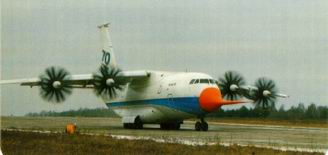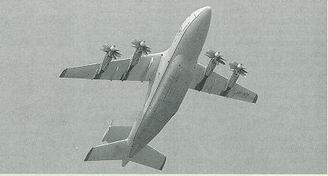Antonov AN-70 – A New Generation Tactical Transport
November 2, 2011
 One of the most revolutionary new systems in the aircraft’s design is its all-composite counter-rotating propeller that gives the aircraft good speed and saves a great deal of fuel, making An-70 the most economical transport aircraft in its class today.
One of the most revolutionary new systems in the aircraft’s design is its all-composite counter-rotating propeller that gives the aircraft good speed and saves a great deal of fuel, making An-70 the most economical transport aircraft in its class today.
 By the time the photo above was taken at Zhukovsky during the MAKS ’97 air and trade show, An-70 made 40 test flights accumulating some 20 hours of total flight time. At the show it was flown by Antonov’s chief test pilot Alexander Galounenko, who demonstrated the aircraft’s amazing agility by executing very steep climbs and near vertical banked turns.
By the time the photo above was taken at Zhukovsky during the MAKS ’97 air and trade show, An-70 made 40 test flights accumulating some 20 hours of total flight time. At the show it was flown by Antonov’s chief test pilot Alexander Galounenko, who demonstrated the aircraft’s amazing agility by executing very steep climbs and near vertical banked turns.
 Powerplants: Four 10,290kW (13,800hp) Progress D-27 propfans driving counter rotating Stupino SV-27 14 blade propellers.
Performance: Cruising speed 750km/h (405kt). STOL takeoff required runway length 900m (2960ft). Range with 20,000kg (44,100lb) of cargo 7400km (3995nm) (3000km/1620nm with STOL takeoff and landing), or 3800km (2050nm) with a 35,000kg (77,161 lb) payload.
Weights: Max takeoff 130,000kg (286,600lb).
Dimensions: Wing span 44.06m (144ft 7in), length 40.25m (132ft 1 in), height 16.10m (52ft 10in).
Accommodation: Flightcrew of two pilots and a flight engineer, plus accommodation for two loadmasters. Designed to accept a large percentage of NATO and CIS military equipment. Standard payload 35 tonnes (77,161 lb), or up to 300 troops.
Operators: None
Armament: None
History: The An-70 has been developed by Antonov as a replacement for its An-12, which is currently in widespread military and civilian use with operators throughout the CIS. Originally designed to be in production in 1988, delays mean it will enter service in 1998.
The An-70 is one of the most recent aircraft to be developed in the Commonwealth of Independent States and incorporates a range of modern technology design concepts. The most prominent feature of the An-70 is its four Russian designed propfans consisting of 14 blade Stupino counter rotating scimitar propellers and the Progress turboprops. Combined these are designed to offer very high speed combined with low fuel consumption. The Russian developed SV-27 all composite propellers are highly swept and are claimed to have a 90% efficiency in cruise, at near jet speeds.
Takeoff and landing speeds are also lower thanks to the propfans, while the An-70′s ability to fly from relatively short fields means it can operate from 80% of all ClS airstrips, allowing shorter journeys and greater point to point flights.
Composite materials are used throughout the airframe, including the horizontal and vertical tails which are all composite. The An-70 also incorporates fly-by-wire and an advanced flightdeck with six full color digital displays and a head up display used for landings on short strips. The digital avionics are also linked via a databus equivalent to US 1553B standard, believed to be another first for a ClS aircraft, and allowing far easier integration of western avionics in the future.
The An-70 program was thrown into doubt in February 1995 when the sole prototype collided with its An-72 chase plane while on a test flight. At that time completion of a second prototype was still some time of, but this aircraft was completed and flew for the first time on April 24 1997. Production aircraft will be built at Kiev with first deliveries planned for 1998.
An-70 models include the basic An-70 military freighter, two crew An-70-100, export An-77 and commercial An-70T. The proposed An-70TK would be a twin propfan convertible passenger/freight aircraft.
(source: The International Directory of Military Aircraft, 1998-1999)
Powerplants: Four 10,290kW (13,800hp) Progress D-27 propfans driving counter rotating Stupino SV-27 14 blade propellers.
Performance: Cruising speed 750km/h (405kt). STOL takeoff required runway length 900m (2960ft). Range with 20,000kg (44,100lb) of cargo 7400km (3995nm) (3000km/1620nm with STOL takeoff and landing), or 3800km (2050nm) with a 35,000kg (77,161 lb) payload.
Weights: Max takeoff 130,000kg (286,600lb).
Dimensions: Wing span 44.06m (144ft 7in), length 40.25m (132ft 1 in), height 16.10m (52ft 10in).
Accommodation: Flightcrew of two pilots and a flight engineer, plus accommodation for two loadmasters. Designed to accept a large percentage of NATO and CIS military equipment. Standard payload 35 tonnes (77,161 lb), or up to 300 troops.
Operators: None
Armament: None
History: The An-70 has been developed by Antonov as a replacement for its An-12, which is currently in widespread military and civilian use with operators throughout the CIS. Originally designed to be in production in 1988, delays mean it will enter service in 1998.
The An-70 is one of the most recent aircraft to be developed in the Commonwealth of Independent States and incorporates a range of modern technology design concepts. The most prominent feature of the An-70 is its four Russian designed propfans consisting of 14 blade Stupino counter rotating scimitar propellers and the Progress turboprops. Combined these are designed to offer very high speed combined with low fuel consumption. The Russian developed SV-27 all composite propellers are highly swept and are claimed to have a 90% efficiency in cruise, at near jet speeds.
Takeoff and landing speeds are also lower thanks to the propfans, while the An-70′s ability to fly from relatively short fields means it can operate from 80% of all ClS airstrips, allowing shorter journeys and greater point to point flights.
Composite materials are used throughout the airframe, including the horizontal and vertical tails which are all composite. The An-70 also incorporates fly-by-wire and an advanced flightdeck with six full color digital displays and a head up display used for landings on short strips. The digital avionics are also linked via a databus equivalent to US 1553B standard, believed to be another first for a ClS aircraft, and allowing far easier integration of western avionics in the future.
The An-70 program was thrown into doubt in February 1995 when the sole prototype collided with its An-72 chase plane while on a test flight. At that time completion of a second prototype was still some time of, but this aircraft was completed and flew for the first time on April 24 1997. Production aircraft will be built at Kiev with first deliveries planned for 1998.
An-70 models include the basic An-70 military freighter, two crew An-70-100, export An-77 and commercial An-70T. The proposed An-70TK would be a twin propfan convertible passenger/freight aircraft.
(source: The International Directory of Military Aircraft, 1998-1999) 

